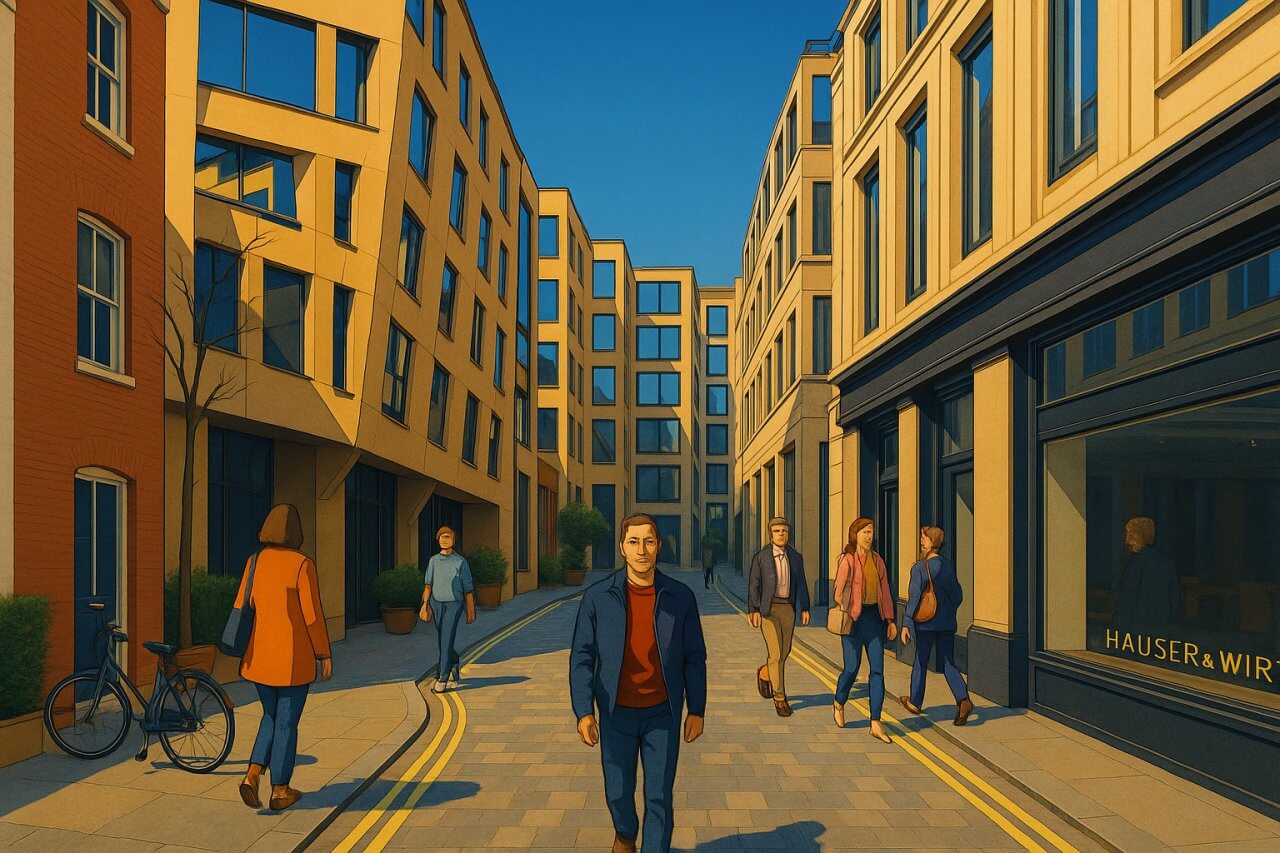
New Burlington Place, London
New Burlington Place is a discreet yet historically resonant street located in the heart of Mayfair, within the City of Westminster. Tucked between the luxury tailoring hub of Savile Row and the grand curve of Regent Street, this short street exemplifies the elegant contrasts of central London—balancing heritage architecture with modern retail sophistication.
Overview and Layout
New Burlington Place is a short east-west road stretching for approximately 100 metres (328 feet). Vehicular access is only possible via Savile Row, which intersects the street at its western end. The eastern section of the street is fully pedestrianised and leads seamlessly into a stylish covered passage that opens onto Regent Street. This transition from car-friendly street to pedestrian zone highlights the mixed-use planning typical of Mayfair’s inner core.
The traffic flow is one-way westbound from Savile Row, and due to its short length and limited access, New Burlington Place experiences very light vehicular traffic. Cyclists and pedestrians can freely navigate both directions.
History and Naming
New Burlington Place dates to the early 18th century, developed as part of the expansion of the Burlington Estate, which also includes New Burlington Street, Cork Street, and Savile Row. The street’s name is derived from the powerful Burlington family, specifically Richard Boyle, the 3rd Earl of Burlington, who was instrumental in shaping the area's aristocratic character through patronage of Palladian architecture.
The name New Burlington Place is typically pronounced as nyoo BUR-ling-ton place, with the phonetic rendering: /njuː ˈbɜː.lɪŋ.tən pleɪs/. The "New" distinguishes it from nearby New Burlington Street, although historically the two have often been considered part of a larger estate layout.
Character and Atmosphere
The street exudes the classic elegance of Mayfair, with a blend of heritage façades and contemporary commercial redevelopment. The buildings reflect a mix of late Georgian brickwork and early 21st-century glass and stone frontages, contributing to an architectural dialogue between old and new. The pedestrianised eastern half features smooth paving, subtle lighting, and planters, creating a boutique urban environment that appeals to both retail visitors and office tenants.
Sights and Surroundings
While New Burlington Place itself is modest in length, it lies within a densely cultural and commercial zone. Notable nearby attractions include:
- Savile Row – World-famous for bespoke tailoring.
- Regent Street – A premier shopping destination with flagship stores.
- Burlington Arcade – A historic shopping arcade dating to 1819.
- Royal Academy of Arts – Situated at nearby Burlington House on Piccadilly.
The passage from New Burlington Place opens directly into the Regent Street entrance of New Burlington House, a landmark commercial building housing high-end retailers and global office tenants. Art exhibitions, fashion launches, and seasonal decorations often enliven this hidden cut-through.
Property and Real Estate
Real estate on and around New Burlington Place is among the most expensive in London. As of early 2025, commercial rental rates in the area average £120–£160 per square foot£1,292–£1,722 per sq m), reflecting the prestige of the location and its proximity to Regent Street.
Residential property is extremely limited, but flats in the immediate vicinity—especially along nearby Savile Row and Clifford Street—typically start at £2.5 million for around 1,000 sq ft (93 sq m), with larger penthouses exceeding £5 million. These prices place the area well above London’s average, underscoring its status as a luxury postcode.
Transport Links
Underground Stations
New Burlington Place enjoys excellent public transport connectivity:
- Oxford Circus Station (about 4 minutes' walk) – Bakerloo, Central, and Victoria lines
- Piccadilly Circus Station (about 7 minutes' walk) – Bakerloo and Piccadilly lines
- Green Park Station (about 10 minutes' walk) – Jubilee, Piccadilly, and Victoria lines
Bus Services
The nearest bus stops are located on Regent Street and Oxford Street, both within 3–5 minutes' walk. They are served by multiple routes including:
- Routes 12, 88, 94, 159, 453 – Running north-south along Regent Street
- Routes 7, 10, 25, 55, 98 – Running east-west along Oxford Street
Fun Fact
A lesser-known curiosity: the pedestrian passage at the eastern end of New Burlington Place forms part of the Regent Street Climate Bond regeneration, which was designed to deliver more sustainable, attractive spaces in central London. The improvements included energy-efficient lighting and pedestrian-focused landscaping—turning a once-forgotten backstreet into an elegant urban corridor.
Quick Facts
- Location: Mayfair, City of Westminster, London
- Length: Approx. 100 metres (328 feet)
- Traffic: One-way westbound from Savile Row; eastern section pedestrianised
- Origin: Early 18th century, part of Burlington Estate
- Name: Named after the Burlington family (pronounced /njuː ˈbɜː.lɪŋ.tən/)
- Nearby sights: Savile Row, Regent Street, Burlington Arcade, Royal Academy of Arts
- Real estate: Commercial rent £120–£160/sq ft (2025); flats from £2.5 million
- Nearest stations: Oxford Circus (Central, Bakerloo, Victoria), Piccadilly Circus, Green Park
- Bus routes: 12, 88, 94, 159, 453 (Regent Street); 7, 10, 25, 55, 98 (Oxford Street)
- Fun fact: Eastern end redesigned as part of Regent Street’s sustainable public realm project
Map of New Burlington Place, London

Painting of New Burlington Place, London (View image in full size)